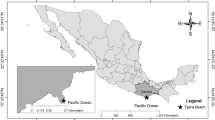Abstract
Crossing tests were made to determine the relationship between the identified Ulva pertusa, which commonly grows in Japan as an attached form on exposed rocks, and the floating Ulva forming "green tide" inside calm bays. The floating Ulva thalli were collected from five major green tide sites in Japan (Yokohama, Mikawa, Miyajima, Kochi and Hakata). Reproductive maturation was induced in U. pertusa and the floating thalli from each site. Mating between induced gametes was observed. It is therefore believed that the floating thalli from Yokohama, Mikawa and Miyajima were mainly U. pertusa, while those from Kochi and Hakata were of a different species (Ulva sp.1). Furthermore, the Ulva species found in Mikawa is also a species (Ulva sp.2) different from both U. pertusa and Ulva sp.1.
Similar content being viewed by others
References
Arasaki, S., 1984. A new aspect of Ulva vegetation along the Japanese coast. Hydrobiologia 116/117: 229–232.
Dion, P., B. de Reviers & G. Coat, 1998. Ulva armoricana sp. nov. (Ulvales, Chlorophyta) from the coasts of Brittany (France). I. Morphological identification. Eur. J. Phycol. 33: 73–80.
Fletcher, R. T., 1996. The occurrence of 'green tide'. In Schramm, W. & P. H. Nienhuis (eds), Marine Benthic Vegetation-Recent Changes and the Effects of Eutrophication. Springer Verlag, Berlin: 7–43.
Hiraoka, M. & S. Enomoto, 1998. The induction of reproductive cell formation of Ulva pertusa Kjellman (Ulvales, Ulvophyceae). Phycol. Res. 46: 199–203.
Hiraoka, M., M. Ohno & S. Kawaguchi, 1998. A note on the reproductive isolation of two types of Ulva (Chlorophyta) growing in Hakata Bay. Jap. J. Phycol. (Sôrui) 46: 161–165.
Kamiya, M., K. Doi, Y. Hara & M. Chihara, 1993. Taxonomic studies on Ulva pertusa (Ulvophyceae). I. Morphological study. Jap. J. Phycol. (Sôrui) 41: 191–198.
Kjellman, F. R., 1897. Marina Chlorophyceer från Japan. Bihang Till K. Sevenska Vet.-Akad. Handlingar. 23: III. 1–44, Pl. 3.
Migita, S., 1985. The sterile mutant of Ulva pertusa Kjellman from Ohmura Bay. Bull. Fac. Fish. Nagasaki Univ. 57: 33–37.
Nordby, Ø., 1977. Optimal conditions for meiotic spore formation in Ulva mutabilis Føyn. Bot. mar. 20: 19–28.
Ohno, M., 1999. Ulva and excessive growth. In Notoya, M. (ed.), The Utilization and Environmental Remediation in Ulva. Seizandou, Tokyo: 1–11.
Stratmann, J., G. Paputsoglu & W. Oertel, 1996. Differentiation of Ulva mutabilis (Chlorophyta) gametangia and gamete release are controlled by extracellular inhibitors. J. Phycol. 32: 1009–1021.
Tokuda, H., S. Kawashima, M. Ohno & H. Ogawa (eds), 1994. A Photographic Guide, Seaweeds of Japan. Midori Shobo Co., Ltd., Japan.
Author information
Authors and Affiliations
Rights and permissions
About this article
Cite this article
Hiraoka, M., Ohno, M., Kawaguchi, S. et al. Crossing test among floating Ulva thalli forming `green tide' in Japan. Hydrobiologia 512, 239–245 (2004). https://doi.org/10.1023/B:HYDR.0000020332.12641.a2
Issue Date:
DOI: https://doi.org/10.1023/B:HYDR.0000020332.12641.a2




